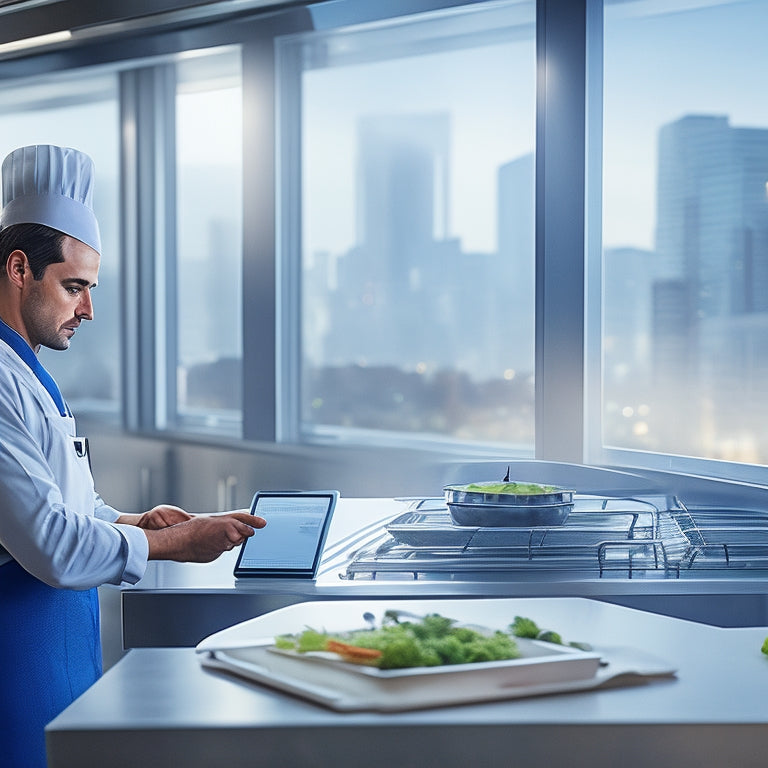
Enhance Food Safety: Permits, Training, Compliance
Share
You can greatly reduce the risk of foodborne illnesses and guarantee a safe dining experience for your customers by obtaining the necessary permits, staying up-to-date on the latest training and compliance regulations, and implementing proper food handling and storage practices. Start by getting your Food Handler Permit, which requires completing the THD Food Safety Class for $20, valid for three years. Stay informed about regulatory updates, maintain accurate records, and regularly review industry standards. By following these guidelines, you'll be well on your way to guaranteeing a safe and healthy environment for your customers - and there's more to explore to take your food safety to the next level.
Key Takeaways
• Obtain necessary permits, such as the Food Handler Permit, and complete the THD Food Safety Class to ensure compliance.
• Adhere to proper handwashing techniques and maintain accurate record keeping to prevent foodborne illnesses.
• Store and handle food safely by refrigerating hot foods within two hours, setting fridge temperatures correctly, and using thermometers to ensure safe internal temperatures.
• Stay updated on regulatory updates and industry standards, and regularly review and implement changes to regulations to maintain compliance.
• Look for 'irradiated' labels on food products, as food irradiation is endorsed by health organizations and reduces foodborne illnesses.
Food Safety Training and Permits
To guarantee a safe and healthy food environment, you must obtain the necessary permits and certifications, starting with the Food Handler Permit, which is mandatory for local food service employees. This permit is obtained by completing a THD Food Safety Class and costs $20, valid for three years. You can carry it as a screenshot or paper copy - easy peasy!
If you're a volunteer serving food, don't worry, you're not off the hook; you'll need a volunteer permit, valid for one year. Study guides in multiple languages are available to help you prep for the exam.
Regulations and Compliance Essentials
You must adhere to proper handwashing techniques, as an essential aspect of food safety regulations, since restaurant inspection reports are public records that can reveal any compliance issues.
Stay on top of inspection protocols and maintain accurate record keeping to avoid any red flags. It's imperative to stay updated on regulatory updates and industry standards to guarantee your business is compliant.
Don't get caught off guard – regularly review and implement changes to regulations, and make sure your team is trained on the latest protocols.
Safe Food Storage and Handling
Properly storing and handling food is essential in preventing bacterial growth and maintaining food quality. Refrigerating hot foods within two hours after cooking greatly reduces the risk of foodborne illness.
You're doing your part in keeping food safe when you store leftovers correctly - they're good for 3 to 5 days in the fridge.
Remember, freezer burn is a quality issue, not a safety concern, and shelf-stable foods can be safe indefinitely.
Proper refrigeration is key, so make sure your fridge is set between 37°F and 40°F.
By following these guidelines, you'll be serving up high-quality food while keeping your customers safe from foodborne illnesses.
Food Irradiation and Safety Benefits
Food irradiation, a process endorsed by health organizations and used in nearly 40 countries, reduces spoilage bacteria, insects, and parasites in food without compromising nutritional quality or making food radioactive.
As you explore this process, you'll discover it's a game-changer for food safety standards. Irradiation benefits include extending shelf life, reducing foodborne illnesses, and preserving nutrients. It's a win-win for consumers and food manufacturers alike!
By embracing irradiation, you'll be contributing to a safer food supply chain. So, next time you're at the grocery store, look out for the 'irradiated' label – it's a sign of a safer, healthier option.
With irradiation, you can enjoy your favorite foods with confidence, knowing they meet the highest food safety standards.
Cooking Temperature Control Measures
When cooking, guaranteeing your food reaches a safe internal temperature is essential, as bacteria multiply rapidly at mid-range temperatures, making accurate temperature readings a top priority.
You don't want to be that person who serves undercooked burgers at the family BBQ! To guarantee temperature accuracy, follow these cooking standards:
-
Calibrate your thermometer: Regularly check your thermometer's accuracy to ensure it's giving you the right readings.
-
Use the right thermometer: Choose a thermometer that's designed for your type of cooking, whether it's meat, poultry, or fish.
-
Place it correctly: Insert the thermometer into the thickest part of the food, avoiding fat and bone.
- Check multiple spots: Take readings from multiple areas to ensure the food has reached a safe internal temperature.
Frequently Asked Questions
What Is the Protocol for Reporting Foodborne Illness Outbreaks?
Imagine a detective on the hunt for a culinary culprit - that's you when reporting a foodborne illness outbreak!
You'll need to spring into action, gathering clues like food receipts, meal timelines, and symptom details.
Then, alert the proper authorities, like local health departments or the FDA, to initiate a food recall and incident response.
Stay vigilant, and remember, time is of the essence in tracking down the source of the outbreak!
How Often Should Commercial Refrigerators Be Cleaned and Sanitized?
You're wondering how often to clean and sanitize those commercial refrigerators? Well, let's get down to business!
Daily cleaning is a must, especially after each use.
Sanitizing should happen every 1-2 weeks, or more often if you're dealing with high-risk foods.
Don't forget to check those temps regularly, ensuring they're between 37°F and 40°F.
Proper Refrigerator Maintenance and Temperature Control are key to keeping your customers safe and your business thriving!
Can Food Handlers Wear Artificial Nails While Working With Food?
You're wondering if those fancy artificial nails can stay on while you're handling food? Unfortunately, the answer is no. Nail sanitation is a major concern, and artificial nails can harbor bacteria, making it tough to maintain hand hygiene.
In fact, the FDA recommends that food handlers avoid wearing artificial nails to prevent the risk of contamination. So, it's time to ditch the glamour and go au naturel when you're on the job!
What Is the Proper Procedure for Cooling Large Quantities of Cooked Food?
'Oh, you're wondering how to cool down that massive vat of chili without turning it into a bacterial breeding ground? Well, wonder no more!
When cooling large quantities of cooked food, you'll want to use shallow metal containers to speed up the process. Then, stick it in an ice bath or a walk-in cooler to get the temperature down to 40°F within two hours.
Don't just let it sit there, or you'll be serving up a side of foodborne illness!'
Are There Any Exemptions for Food Safety Permits for Small, Private Events?
You're wondering if you need a food safety permit for that backyard BBQ or family reunion? Well, you're in luck! There are catering exemptions for small, private events.
If you're not selling food and it's a one-time deal, you're usually exempt from permit requirements. However, it's always best to check with local authorities for specific event exceptions.
Better safe than sorry, right?
Related Posts
-

Unlock Attic Storage Potential With Online Guides
You're sitting on a treasure trove of storage space, right above your head! Reveal your attic's hidden potential by a...
-

Budget-Friendly Ideas for a Cozy Home Library
You can transform any space into a cozy home library without breaking the bank. Start by decluttering your book colle...
-

Effortless Home Organization Systems for Busy Families
You can create an effortless home organization system that caters to your busy family's unique needs and routines. St...


